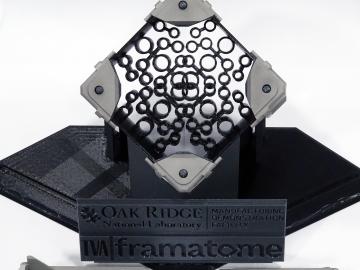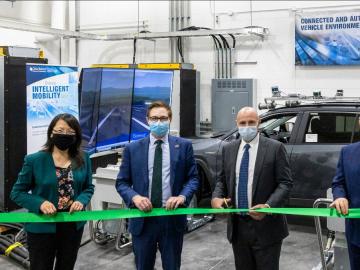
Filter News
Area of Research
- Advanced Manufacturing (3)
- Biology and Environment (47)
- Computational Engineering (1)
- Computer Science (2)
- Energy Science (64)
- Fuel Cycle Science and Technology (1)
- Fusion and Fission (30)
- Fusion Energy (5)
- Isotope Development and Production (1)
- Isotopes (4)
- Materials (48)
- Materials for Computing (10)
- National Security (17)
- Neutron Science (18)
- Nuclear Science and Technology (25)
- Quantum information Science (5)
- Sensors and Controls (1)
- Supercomputing (77)
News Type
News Topics
- (-) Big Data (58)
- (-) Composites (24)
- (-) Mercury (9)
- (-) Nuclear Energy (99)
- (-) Polymers (25)
- (-) Quantum Science (80)
- (-) Security (30)
- (-) Summit (62)
- 3-D Printing/Advanced Manufacturing (108)
- Advanced Reactors (25)
- Artificial Intelligence (114)
- Bioenergy (95)
- Biology (108)
- Biomedical (61)
- Biotechnology (36)
- Buildings (50)
- Chemical Sciences (72)
- Clean Water (19)
- Computer Science (180)
- Coronavirus (37)
- Critical Materials (17)
- Cybersecurity (31)
- Education (5)
- Element Discovery (1)
- Emergency (3)
- Energy Storage (80)
- Environment (162)
- Exascale Computing (64)
- Fossil Energy (7)
- Frontier (61)
- Fusion (56)
- Grid (50)
- High-Performance Computing (114)
- Hydropower (6)
- Isotopes (55)
- ITER (6)
- Machine Learning (53)
- Materials (113)
- Materials Science (120)
- Mathematics (9)
- Microelectronics (4)
- Microscopy (44)
- Molten Salt (5)
- Nanotechnology (50)
- National Security (81)
- Neutron Science (139)
- Partnerships (67)
- Physics (65)
- Quantum Computing (48)
- Simulation (54)
- Software (1)
- Space Exploration (16)
- Statistics (3)
- Transportation (61)
Media Contacts

There are more than 17 million veterans in the United States, and approximately half rely on the Department of Veterans Affairs for their healthcare.

An international multi-institution team of scientists has synthesized graphene nanoribbons – ultrathin strips of carbon atoms – on a titanium dioxide surface using an atomically precise method that removes a barrier for custom-designed carbon

New capabilities and equipment recently installed at the Department of Energy’s Oak Ridge National Laboratory are bringing a creek right into the lab to advance understanding of mercury pollution and accelerate solutions.

The Transformational Challenge Reactor, or TCR, a microreactor built using 3D printing and other new advanced technologies, could be operational by 2024.

Popular wisdom holds tall, fast-growing trees are best for biomass, but new research by two U.S. Department of Energy national laboratories reveals that is only part of the equation.

Momentum Technologies Inc., a Dallas, Texas-based materials science company that is focused on extracting critical metals from electronic waste, has licensed an Oak Ridge National Laboratory process for recovering cobalt and other metals from spent

Four research teams from the Department of Energy’s Oak Ridge National Laboratory and their technologies have received 2020 R&D 100 Awards.

ORNL and Department of Energy officials dedicated the launch of two clean energy research initiatives that focus on the recycling and recovery of advanced manufacturing materials and on connected and

The combination of bioenergy with carbon capture and storage could cost-effectively sequester hundreds of millions of metric tons per year of carbon dioxide in the United States, making it a competitive solution for carbon management, according to a new analysis by ORNL scientists.

Prometheus Fuels has licensed an ethanol-to-jet-fuel conversion process developed by researchers at Oak Ridge National Laboratory. The ORNL technology will enable cost-competitive production of jet fuel and co-production of butadiene for use in renewable polymer synthesis.


